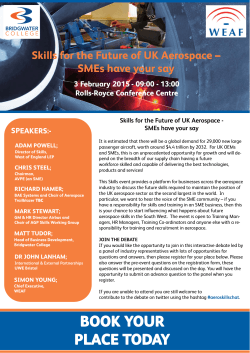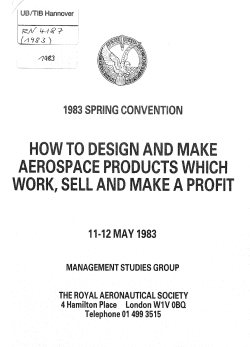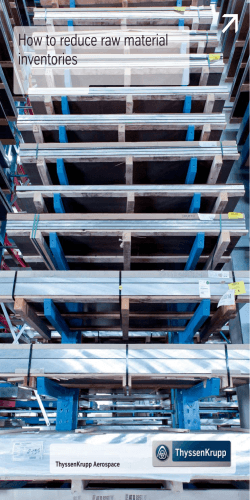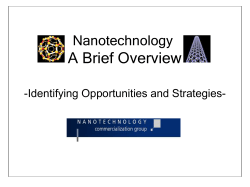
N I A ANOTECHNOLOGY
NANOTECHNOLOGY IN AEROSPACE APPLICATIONS “The problems of chemistry and biology can be greatly helped if our ability to see what we are doing, and to do things on an atomic level, is ultimately developed--a development which I think cannot be avoided.” –Richard P. Feynman Team S5 Pradip Rijal, Jason Savatsky, Trevor Seidel, and Laura Young THE FOCUS NASA Commercial Military http://corvusart.com/blog/wp-content/uploads/2008/10/fishbowl2.jpg WHAT DOES THE INDUSTRY WANT? Materials that are: Lighter Stronger More Durable Resistant to Extreme Conditions Also interested in materials that have unique properties http://www.washingtonstatewire.com/admin/contentmanager/photos/191409072 2%20Boeing%20787.jpg THE TECHNOLOGIES Improved Electronics Advanced Composites Improved Paints and Sealants Carbon Nanotubes http://static.commentcamarche.net/en.kioskea.net/faq/images/372-phenom-x4processors-01-s-.png OUR ROLE Advanced material research Electronics Production http://www.europavalve.com/images/chemical-plant.jpg AEROSPACE NANOTECHNOLOGY: NASA High level of funding Four Areas of Focus Materials Electronics and Data Processing Sensors and Components Basic Research http://www.azonano.com/details.asp?ArticleID=1174 NASA: COMPUTER TECHNOLOGY Carbon Nanotube SPM Tips Moore’s Law Manipulate molecules with sub-angstrom accuracy Engrave patterns on silicon surface Application to electronics http://nanotechnologytoday.blogspo t.com/2007_09_01_archive.html NASA: AEROSPACE TRANSPORTATION Launch Vehicles Diamondoid material Price of diamondoid vehicles compared to that of titanium vehicles Carbon nanotubes have a Young’s modulus comparable to diamond http://pix.motivatedphotos.com/2009/5/15/633780049382659605-USSenterprise.jpg NASA: AEROSPACE TRANSPORTATION Space Elevator http://www.cmp.caltech.edu/refael/league/Space_elevator2.jpg Cable from Earth to space Strength of cable must be tapered Taper factor of steel and diamond Material must be stronger than current technology provides Safety is still an issue NASA: ACTIVE MATERIALS The smallest feature size in production systems: 250 nm Nanotubes are smaller Human tissue as an active material http://www.ndriresource.org/SiteData/images/20042C/9d 57dcc0be146cf6680a7085b8c25615/20042C.jpg NASA NANOTECHNOLOGY VIDEO http://www.azonano.com/nanotechnology-videodetails.asp?VidID=143 INDUSTRIAL/COMMERCIAL APPLICATIONS Advanced Composites Materials Aerospace Paint Deicing Materials http://www.backpackersguide.co.uk/images/plane-travel.jpg ADVANCED COMPOSITES MATERIALS Composites materials are combinations of two or more organic or inorganic components Consist of high strength nano fibers embedded in a matrix Materials are: Matrix material: material that holds everything together. e g . epoxy, bismaleimide, or polyimide. o Fibers: serve as a reinforcement, embedded in the matrix. e g. glass fiber, boron fiber, carbon fiber Schematic section of a helicopter rotor blade o http://authors.library.caltech.edu/5456/1/hrst.mit.edu/hrs/materials/public/composites/Compo sites_rotor.gif ADVANCED COMPOSITES MATERIALS Nano Fibers are laid out in tape or fabric form put in a mold under heat and pressure. The resin matrix flows over nano fibers Heat is remover and it solidifies. It can be formed into various shapes. In some cases, the fibers are wound tightly to increase strength. http://people.sabanciuniv.edu/~yusufm/research/composite.jpg ADVANCED COMPOSITES MATERIALS Traditionally used: Aluminum metal Aluminum made planes heavier, consume more fuel Fiberglass was first used in the Boeing 707 passenger jet in the 1950s, only 2% of the structure. Now , about one-third of the structure of the commercial planes uses composites Composites are stronger Composites makes aircrafts lighter :~ 20% lighter Fuel efficient http://oea.larc.nasa.gov/PAIS/Concept2Reality/graphics/fig060.jpg AEROSPACE PAINT AND SEALANT Sealants to seal the structures like fuel tanks, aerodynamic sealing, and windshield installation Based on nanotechnology e. g. PRC® and Pro-Seal™ PPG Aerospace chromate-free de-paint/repaint process includes a epoxy primer Based on nanotechnology Environment friendly Better adhesion Corrosion resistant e. g. DeSoto® Aerospace Coatings http://www.aerospace-technology.com/contractors/paints/ppgaerospace/ppg-aerospace3.html DEICING •When a plane is in the air, icing can occur •plane’s performance suffers and disasters can occur. •Currently used techniques: •use bleed air: heating the surface with engine bleed air •mechanical boot: breaking the bond between surface and ice http://news.bbc.co.uk/2/hi/8504734.stm • Issues: •Too complex, •too heavy •draws too much power to be effective http://www.nano.org.uk/news/370/ DEICING Solution by scientists at Battelle, U. K. : deicing fluid is based on nano technology weighs 1/100th of current ice protection systems uses simple painting methods can be applied to a variety of curved surfaces without needing a custom heater pad design. How? sprayed on planes prior to flight. carbon nanotube coating is applied to surfaces then energize that coating using the plane’s on-board electrical system. causes the nanotube coating to heat up, thus preventing ice from forming. MILITARY APPLICATIONS http://base1.googlehosted.com/base_media?q=http://www.capitolsu pply.com/ImageServer.ashx%3Ft%3Dproduct%26h%3D200%26w% 3D200%26imageid%3DCS8516813&size=20&dhm=fdfe56f1&hl=en Satellites weighing 15 tons or more derive 1/3 of their weight from copper harnesses Boeing 747 uses up to 135 of copper wire that can weight more than 4000 pounds Copper wires also oxidize and corrode, are susceptible to vibration fatigue, and create premature electronics failures due to overheating conditions. Will replace copper wiring on aerospace systems with carbon nanotube sheets MILITARY APPLICATIONS Conductive coating to be used on jet fighter canopies - clear bubbles that cover planes' cockpits - for the US air force Coating will improve electromagnetic shielding and electrostatic discharge to prevent electronic disruption http://upload.wikimedia.org/wikipedia/commons/thumb/c/c9/F16_June_2008.jpg/800px-F-16_June_2008.jpg REFERENCES http://www.azonano.com/details.asp?ArticleID=11 74#_The_Main_Nanotechnology_Sectors%20tha http://alglobus.net/NASAwork/papers/nano1997/ap plications/ Group S5 Nanotechnology and Aerospace Applications Rebuttal S5 Rebuttal of Presentation 2 • S5 feels that for the most part, the criticism was accurate and just. Laura should have tried to memorize the material to a greater extent and not read from notes as much. Pradip had extensive writing on his slides, as the audience reviewed on. Jason could have put more effort into his slides and rehearsed his part. More research would have been good too. One of the reviews commented on the irrelevance of the futuristic things that NASA is working on as they are too far in the future, however, these are big projects and definitely worth focusing on now. I think that we should have discussed the space elevator—it shows that NASA is aimed toward highly technological advances and is focused on succeeding in their goals. Presentation: Nanotechnology and Aerospace Applications By Group 5 Good presentation skills ◦ Seemed knowledgeable ◦ Good pace ◦ Three of the presenters showed good preparation skills, except last presenter. Slides had good format ◦ Good graphics Presenters answered questions with further information than what was presented Enough presentation was presented by the first presenters to make up for lack of information by the fourth presenter. Jason must improve speaking skills ◦ Seemed in a hurry to finish presentation ◦ Read straight from slides Laura was able to get the audience’s attention; however, less reading from notes would have increased interaction with audience. One of the slides from composite material section seemed overcrowded as well as the last two slides o Design of the slides could have been more creative. Group S2’s Review of S5 Second Presentation Micheal Jones Rachel Houk Chris Heflin Positive Aspects • Appearance of the Slides – The layout was professional – Figures were relevant to the concepts being described and helped with understanding – Text to figure ratio was acceptable • Oral Presentation – For the most part, the presenters seemed prepared with the use of minimal filler words and good posture and body language Room for Improvement • Consistency – The formatting and aesthetics of a few slides were inconsistent, it seemed as though one group member through his slides in last minute without formatting with the rest of the group – Other than that, some of the slides that were consistent format wise had too much text with respect to the other slides and seemed out of place • Preparation – The group as a whole seemed well prepared except for the last presenter. He seemed as though this was the first time he was actually going over his material. Although this is not the rest of the groups responsibility, it would be more professional if he would have pulled his own weight in the presentation. By S3: James Kancewick Michael Koetting Bradford Lamb Positives Slides were well-made and contained a nice text-to- image ratio. Speaking was fairly good through the first three presenters. Contained a lot of good technical information regarding the applications, especially in regard to the “Advanced Composite Materials” slides. Areas for Improvement The final presenter really needs to practice more. He seemed very nervous and unsure of himself. His entire section was very short and was read completely off the slides, with his speaking adding nothing to the presentation. Rehearsal would have greatly helped! Use of the video by NASA was somewhat distracting. The information from the video should have just been incorporated into your slides, with you presenting the information. This would have reinforced your position as the “experts” on the topic, rather than deferring to outside expertise. Occasional format discrepancies between slides (e.g. different bullets, inconsistent capitalization, etc.) Speakers seemed to be lacking knowledge of the material during the Q/A section, especially regarding the space elevator. Danielle Miller Joshua Moreno Scott Marwil Good Things Slides looked very professional. Pictures were vibrant and great attention grabbers. Laura and Trevor were very strong presenters, they did a great job of keeping the attention of the audience and delivering their message. Prapid was a good presenter, but was soft spoken. Just needed to speak up and show more energy. Places for Improvement Jason was very nervous. Said “uh” and “um” a lot. He did not appear to be well rehearsed- giant pause at the beginning. His section was less developed than other sections of the presentation. All these things can be easily fixed by rehearsing and putting more time into preparation. Laura read from notes. Try to have more memorized, but it was not that distracting. Places for Improvement Use consistent and parallel structure in bulleted lists. Punctuation should be consistent throughout slide (have all statements start with a capital letter & use clauses OR complete sentences). Some slides had too many words on them. This takes the attention away from your main point you are trying to get across. S6 CHEN 481 2nd Presentation by S5 Review John Baumhardt Daniel Arnold Michael Trevathan Michael Tran Presentation Review • Slide layout was agreeable and pleasant to look at. The text on the slides seemed to be occasionally light on content in the presentation. • The presentation was detailed and well thought out. • The final comment holds true throughout both of the presentations: the final presenter was sub-par when compared with the rest of the group. Everybody has difficulties when it comes to presentations, but practice serves to eliminate these difficulties. The fact that there was no improvement between the presentations means that no effort has been made to improve, and this is unfair to the rest of your group. Critique of Information • The applications of nanotechnology in aerospace were very interesting. Some of the applications appear to be so far in the future that they are not worth mentioning, such as the space elevator. • Would have liked to see an analysis for the time estimate to implement the carbon nano-tubes in the replacing copper wires. • Since there are other advancing aerospace programs, we would have liked to know about any other applications that these programs are exploring. We would like to know if these programs are progressing in this research more rapidly then NASA.
© Copyright 2026





















